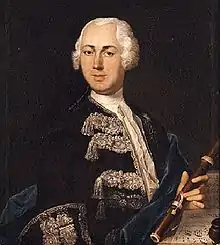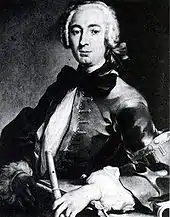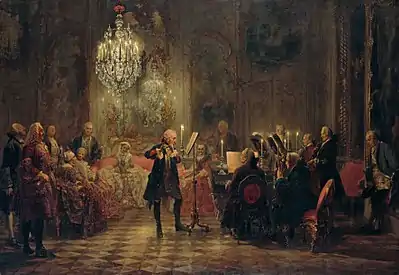Johann Joachim Quantz
Johann Joachim Quantz (German: [kvants]; 30 January 1697 – 12 July 1773) was a German flutist, flute maker and Baroque music composer. He composed hundreds of flute sonatas and concertos, and wrote On Playing the Flute, a treatise on flute performance. His works were known and appreciated by Bach, Haydn and Mozart.
Johann Joachim Quantz | |
|---|---|
 Portrait by Johann Friedrich Gerhard, 1735 | |
| Born | 30 January 1697 |
| Died | 12 July 1773 (aged 76) Potsdam, Germany |
Works | List of compositions by Johann Joachim Quantz |
Biography


Quantz was born as Hanß Jochim Quantz[1] in Oberscheden, near Göttingen, in the Electorate of Hanover. His father, Andreas Quantz, was a blacksmith who died when Hans was not yet 11; on his deathbed, he begged his son to follow in his footsteps. Nevertheless, from 1708 to 1713 he began his musical studies as a child with his uncle Justus Quantz, a town musician in Merseburg; he also studied for a time with a cousin's husband, the organist Johann Friedrich Kiesewetter. From 1714 on, Quantz studied composition extensively and pored over scores of the masters to adopt their style.[2]
In 1716 he joined the town band in Dresden, where in 1717 he studied counterpoint with Jan Dismas Zelenka. In March 1718 he was appointed oboist in the newly formed Dresden Polish Chapel of August II, Elector of Saxony and King of Poland. As it became clear that he couldn't advance as an oboist in the Polish Chapel, Quantz decided to pursue the flute, studying briefly in 1719 with Pierre-Gabriel Buffardin, principal flute in the Royal Orchestra. He became good friends with Johann Georg Pisendel, concertmaster of the Royal Orchestra, who greatly influenced his style.[2]
Between 1724 and 1727 Quantz completed his education by doing a "Grand Tour" of Europe as a flutist. He studied counterpoint with Francesco Gasparini in Rome, met Alessandro Scarlatti in Naples, befriended the flutist Michel Blavet in Paris, and in London was encouraged by Handel to remain there. In 1728 Quantz accompanied August II on a state visit to Berlin. The Queen of Prussia was impressed and wanted to hire him. Though August II refused, he allowed Quantz to travel to Berlin as often as he was asked to. That year the Crown Prince, Frederick II of Prussia (Frederick the Great), decided to study the flute and Quantz became his teacher for several visits a year. Quantz later told writer Friedrich Nicolai that he once had to hide in a closet during an outburst of Frederick's domineering father, who disapproved of his son's musical studies. Until 1741 Quantz remained at the Saxon Court in Dresden. He married Anna Rosina Carolina Schindler in 1737; the marriage was not happy, and it was generally known in Berlin that Quantz's wife tyrannized him.
When Frederick II became King of Prussia in 1740, Quantz finally accepted a position as flute teacher, flute maker and composer at the court in Berlin. He joined that court in December 1741 and stayed there for the rest of his career.[2] He made flutes from at least 1739 and was an innovator in flute design, adding a second key (Eb, in addition to the standard D#) to help with intonation, for example.
As well as writing hundreds of sonatas and concertos, mainly for the flute, he is known today as the author of Versuch einer Anweisung die Flöte traversiere zu spielen (1752) (titled On Playing the Flute in English), a treatise on traverso flute playing. It is a valuable source of reference regarding performance practice and flute technique in the 18th century.
Quantz remained at Frederick's court at Potsdam until his death in 1773. A biography appeared in 1755 in Friedrich Wilhelm Marpurg's Historisch-kritischen Beyträgen zur Aufnahme der Musik; another, in Italian, followed in 1762. His grandnephew, Albert Quantz, published a full-length biography in 1877.
Few of Quantz's works were published during his lifetime. Most of them are for transverse flute, including more than 200 sonatas, around 300 concertos, including several for two flutes; around 45 trio sonatas (mostly for 2 flutes or flute and violin, with continuo); 6 quartets for flute, violin, viola and continuo; various flute duets and flute trios; and unaccompanied caprices and fantasias for flute.
List of works
The thematic catalog for Quantz's works was published by Horst Augsbach.[3] 'QV' stands for 'Quantz Verzeichnis', and 'Anh.' for 'Anhang' ("supplement") when the authenticity of the works is in doubt. A number of additional works have been discovered or come to light since its publication.
References
- Horst E. Gerke, Jühnder Mitteilungen, Vol. 18, Eigenverlag, October 2011, p. 603 (in the Archiv der Ev. Kirche Hannover).
- Biography with translated excerpts of Quantz's autobiography at a Elysium ensemble's website.
- H. Augsbach, Johann Joachim Quantz: Thematisch-systematisch Werkverzeichnis, (Stuttgart, Carus-Verlag, 1997)
Further reading
- Oleskiewicz, Mary. “Quantz’s Flute Quartets Lost and Found,” Flute Talk 24 (April 2005): 13–20.
- Oleskiewicz, Mary. “Quantz’s Quatuors and Other Works Newly Discovered,” Early Music 31 (2003): 484–505.
- Oleskiewicz, Mary. Johann Joachim Quantz: Six Quartets for Flute, Violin, Viola, and Basso Continuo (Ann Arbor: Steglein Publishing, 2004).
- Oleskiewicz, Mary. Johann Joachim Quantz: Seven Trio Sonatas, Recent Researches in Music of the Baroque Era, vol. 111 (Middleton, Wis.: A-R Editions, 2001).
- Oleskiewicz, Mary. “The Flutes of Quantz: Their Construction and Performing Practice,” Galpin Society Journal 52 (2000): 201–220.
- Oleskiewicz, Mary. Quantz and the flute at Dresden: his instruments, his repertory, and their significance for the "Versuch" and the Bach circle. PhD diss., Duke University, 1999.
- Oleskiewicz, Mary. “The Trio in Bach’s Musical Offering: A Salute to Frederick’s Tastes and Quantz’s Flutes?,” in Bach Perspectives, Volume 4: The Music of J.S. Bach: Analysis and Interpretation, ed. David Schulenberg (Lincoln: University of Nebraska Press, 1999), 79–110.
- Oleskiewicz, Mary. “Eine Quantz-Flöte in Halle? Zuordnungen und Überlegungen zu Quantz als Flötenbauer,” in Festschrift für Rainer Weber, Scripta Artium, vol. 1 (Leipzig: Universität Leipzig, 1999), pp. 79–84.
- Oleskiewicz, Mary. “A Museum, a World War, and a Rediscovery: Flutes by Quantz and Others from the Hohenzollern Museum,” Journal of the American Musical Instrument Society 24 (1998): 107–45.
- Reilly, Edward (1971). Quantz and his Versuch: three studies. Studies and documents (American Musicological Society), no. 5. New York American Musicological Society. OCLC 147901.
- Schmitz, Hans-Peter (1987). Quantz heute: Der "Versuch einer Anweisung die Flöte traversiere zu spielen" als Lehrbuch für unser Musizieren. Bärenreiter: Kassel. OCLC 17658485.
- Kachmarchyk, Vladimir (2009). German flute art in XVIII-XIX centuries. Kyiv: Diss.
- Kachmarchyk, Vladimir (2008). German flute art in XVIII-XIX centuries. Denetsk: Yugo-Vostok. ISBN 978-966-7271-44-2.
- Quantz, Johann Joachim (1985). On playing the flute (trans. by Edward R. Reilly) ((March 1, 2001) 2nd ed.). Northeastern. p. 423. ISBN 978-1-55553-473-8.
External links
| Wikimedia Commons has media related to Johann Joachim Quantz. |
- A biography of Quantz taken largely from his autobiography published in 1754–5
- Information about the Quantz association
- Free scores by Johann Joachim Quantz at the International Music Score Library Project (IMSLP)
- The Mutopia Project has compositions by Johann Joachim Quantz
- The Quantz Project - The complete works recorded by Benedek Csalog & Alexis Kossenko